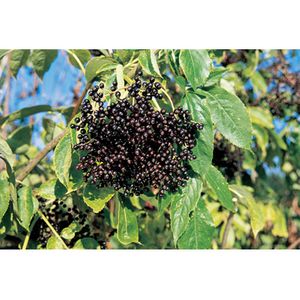

 | Elderberry 'Nova' 5 gal Sambucus canadensis. The 'Nova' elderberry is one of the most ornamental edibles you could grow. The huge creamy white flower clusters add drama to bouquets and the garden, especially when they're covered in butterflies. As the shiny dark purple berries ripen, the branches bend gracefully with the weight. Then it's time to grab your buckets and pick the berries! These bushes are fast growers. Bears fruit in midsummer. To 12' x 8' or more, but easy to prune to a smaller size. Zones 4-9. Grown and shipped in 5 gal containers. Plants are now dormant. | |
 | Elderberry 'York' 5 gal Sambucus canadensis. The 'York' elderberry is nearly identical to 'Nova' except that 'York' berries ripen a few weeks later. Like all its brethren, 'York' is carefree and will grow in dry or wet soil, although the berry production is best with adequate summer water. Pinnate leaves gives a tropical air to this easy grower. And it's one of the few fruiting plants that can provide berries in partial shade. Self-fruitful, but like all elderberries will provide more berries if planted near another variety. Elderberry wine has the most beautiful claret color you'll ever see. To 12' x 8'. Zones 4-9. Grown and shipped in 5 gal containers. Plants are now dormant. TEMPORARILY OUT OF STOCK. | |
 | Sambucus 'Black Beauty' Sambucus nigra. The Maria Callas of elderberries, 'Black Beauty' demands your attention and then rewards you with a dramatic display throughout the season. Also known as 'Gerda', this shrub's darkest purple foliage is more effective and long-lasting than that of other cultivars. And those flowers! No other shrub offers ten-inch cymes of pink flowers scented with citrus. The shiny black berries that follow are so prolific they weigh down the branches. 10' x 8,' bigger in mild climates. Full sun for best foliage color and berry production in cool summer areas. Filtered sun in hot summer areas. Moist to dry soil. Plants in 1-gal containers, about 12" tall. Zones 4-9. Can be cut back to keep in bounds. Truly remarkable in a woodland setting with Corydalis flexuosa 'Pere David' nestled at its feet. TEMPORARILY OUT OF STOCK. | |
 | Sambucus 'Black Lace' Sambucus nigra. Even the jaded will drop their jaws when they lay their eyes on this new elderberry, also known as 'Eva.' The purple-black foliage is deeply imbricated and looks for all the world like a cutleaf Japanese maple. Until, that is, the massive pink flower heads appear. If you don't pick the flowers, you'll be rewarded with drooping clusters of reddish black berries for jam and wine. To 8' x 6', but can be cut back every year and grown as a perennial. Will be double that size in mild climates without pruning. Highly adaptable. Grow in full sun in cool summer areas for best foliage color and berry production, filtered sun in hot summer areas. Can take moist or dry soils. Self-fertile, but will bear most fruit if pollinated by another variety. Grown in 1-gal containers, plants about 15" tall. Zones 4-9. | |
 | Elderberry 'Goldbeere' Sambucus nigra. The only golden-berried elderberry, 'Goldbeere' was developed by German growers, a group that doesn't mess around when it comes to plant breeding. Shrub is more upright than other European cultivars and very productive. Since this is a nigra selection, you need to process the berries to make them edible, either by cooking or wine-making. Fabulous with the native Scuppernong grape in jams or jellies. And if you're looking for golden berries for flower arrangements in mid-summer, these branches are unsurpassed in mixed bouquets with Clematis rehderiana and the climbing rose 'Celine Forestier.' Grown in 1 gal containers. | |
